Lose electrons - Study guides, Class notes & Summaries
Looking for the best study guides, study notes and summaries about Lose electrons? On this page you'll find 1679 study documents about Lose electrons.
Page 3 out of 1.679 results
Sort by
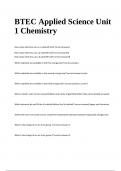
-
BTEC Applied Science Unit 1 Chemistry (2024/2025 Graded)
- Exam (elaborations) • 31 pages • 2024
-
- $11.49
- + learn more
BTEC Applied Science Unit 1 Chemistry (2024/2025 Graded) How many electrons can a d subshell hold? correct answer10 Which subshells are available in the first energy level? correct answers Which subshells are available in the second energy level? correct answers and p Which subshells are available in the third energy level? correct answers, p and d What is Hund's rule? correct answerOrbitals must all be singly filled before they can be doubly occupied Which elements do not fill the 4s subs...

-
Bio 1320 Bergh Final Exam Questions With Correct Solutions, Already Passed!!
- Exam (elaborations) • 32 pages • 2024
-
- $7.99
- + learn more
Describe the process of transcription, in detail. - A) Initiation: RNA polymerase binds to the promoter, which is the beginning of the gene. inert atom - with a filled outer valence shell an inert atom is not able to gain or lose an electron and therefore is not able to participate in any chemical reactions. they are very stable Difference between hypothesis and theory - Hypothesis is an educated guess Theory is an explanation about something in the natural world. (has been repeatedly teste...
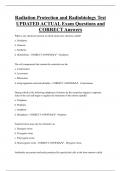
-
Radiation Protection and Radiobiology Test UPDATED ACTUAL Exam Questions and CORRECT Answers
- Exam (elaborations) • 33 pages • 2024
-
- $10.49
- + learn more
Radiation Protection and Radiobiology Test UPDATED ACTUAL Exam Questions and CORRECT Answers What is any chemical reaction in which atoms lose electrons called? a. Oxidation b. Osmosis c. Synthesis d. Metabolism - CORRECT ANSWER- Oxidatio
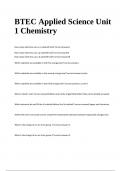
-
BTEC Applied Science Unit 1 Chemistry (Graded)
- Exam (elaborations) • 31 pages • 2024
-
- $12.99
- + learn more
BTEC Applied Science Unit 1 Chemistry (Graded) How many electrons can a d subshell hold? correct answer10 Which subshells are available in the first energy level? correct answers Which subshells are available in the second energy level? correct answers and p Which subshells are available in the third energy level? correct answers, p and d What is Hund's rule? correct answerOrbitals must all be singly filled before they can be doubly occupied Which elements do not fill the 4s subshell befor...
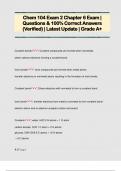
-
Chem 104 Exam 2 Chapter 6 Exam | Questions & 100% Correct Answers (Verified) | Latest Update | Grade A+
- Exam (elaborations) • 20 pages • 2024
-
- $11.49
- + learn more
Covalent bonds: Covalent compounds are formed when nonmetals share valence electrons forming a covalent bond. Ionic bonds: Ionic compounds are formed when metal atoms transfer electrons to nonmetal atoms resulting in the formation of ionic bonds. Covalent bond: Share electrons with nonmetal to form a covalent bond Ionic bond: transfer electrons from metal to nonmetal to form covalent bond - electron donor and an electron acceptor (cation and anion) Covalent: water, H2O 2 H atoms + 1 O ato...
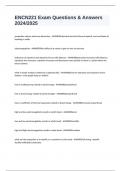
-
ENCN221 Exam Questions & Answers 2024/2025
- Exam (elaborations) • 28 pages • 2024
-
Available in package deal
-
- $10.49
- + learn more
ENCN221 Exam Questions & Answers 2024/2025 properties valence electrons determine - ANSWERSchemical electrical thermal optical, and contribute to bonding in solids electronegativity - ANSWERSthe ability of an atom to gain or lose an electron behaviour of repulsive and attractive forces with distance - ANSWERSattraction increases with distance, repulsion also increases. repulsion increases and decreases more quickly so there is a point where the forces balance what is elastic modulu...

-
Green River College: BIOL 100 Unit 3 Notes Latest Updated,100% CORRECT
- Class notes • 116 pages • 2023
-
- $16.99
- 1x sold
- + learn more
Green River College: BIOL 100 Unit 3 Notes Latest Updated Chapter 6: Energy for life Learning Objectives: 1. Identify the cellular structure where photosynthesis occurs and describe its function. 2. State the overall chemical equation for photosynthesis. 3. Recognize what is meant by the terms reduction and oxidation. 4. Describe the function of photosynthetic pigments. 5. Explain the flow of electrons in the light reactions. 6. Explain how ATP and NADPH are generated in the light reac...

-
Bio 93 Midterm Review (Test Questions) with 100% Correct Answers
- Exam (elaborations) • 29 pages • 2024
- Available in package deal
-
- $12.49
- + learn more
Bio 93 Midterm Review (Test Questions) with 100% Correct Answers Which of the following properties or processes do we associate with living things? A) evolutionary adaptations B) energy processing C) responding to the environment D) growth and reproduction E) all of the above - Correct Answer ️️ -e The lowest level of biological organization that can perform all the activities required for life is the A) organelle-for example, a chloroplast. B) cell-for example, a skin cell. C) t...
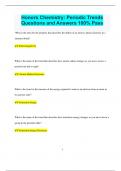
-
Honors Chemistry: Periodic Trends Questions and Answers 100% Pass
- Exam (elaborations) • 13 pages • 2024
- Available in package deal
-
- $9.99
- + learn more
Honors Chemistry: Periodic Trends Questions and Answers 100% Pass What is the term for the property that describes the ability of an atom to attract electrons in a chemical bond? Electronegativity What is the name of the trend that describes how atomic radius changes as you move across a period from left to right? Atomic Radius Decreases What is the term for the measure of the energy required to remove an electron from an atom in its gaseous state? Ionization Energy What ...
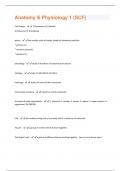
-
Anatomy & Physiology 1 (SCF) Questions and answers
- Exam (elaborations) • 16 pages • 2024
- Available in package deal
-
- $7.99
- + learn more
Cell Shapes - 1) Squamous 2) Cuboidal 3) Columnar 4) Transitional atoms - the smalles units of matter (made of subatomic particles- * protons (+) * neutrons (neutral) * electrons (-) physiology - study of functions of anatomical structures cytology - study of cells &their functions histology - study of tissues & their structures microscopic anatomy - examines cells & molecules Six levels of body organization - 1. chemical. 2. cellular. 3. tissues. 4. organs. 5. organ systems. 6. organ...

Study stress? For sellers on Stuvia, these are actually golden times. KA-CHING! Earn from your study resources too and start uploading now. Discover all about earning on Stuvia


